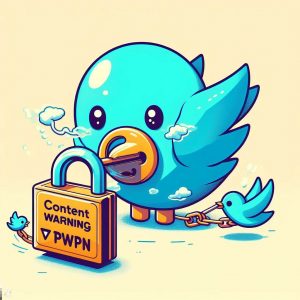I. Introduction
A Virtual Private Network (VPN) is a technology that allows users to access the internet privately and securely by routing their connection through an encrypted tunnel. Using a VPN can help bypass geographic restrictions, censorship, and surveillance when accessing sites like Twitter.
In some countries, sites like Twitter may be blocked or restricted by governments or internet service providers. By using a VPN service and connecting through servers located outside these restrictive regions, users can bypass these blocks to access Twitter freely.
VPNs have become an essential tool for many internet users who want to protect their online privacy and data. When it comes to accessing blocked sites like social media platforms, a VPN can mean the difference between being connected or disconnected from conversations happening around the world.
II. Using a VPN to Unblock Twitter
Using a VPN to access blocked or restricted sites like Twitter typically requires just a few simple steps:
- Sign up for a reputable VPN service. Look for VPNs that clearly state they allow access to sites like Twitter and do not log user activity.
- Download and install the VPN service’s app on your device (desktop, mobile, etc). Most major VPNs have user-friendly apps for all major operating systems.
- Connect to a VPN server located in a country that does not restrict access to Twitter. This is usually countries like the United States, Canada, or Western European nations.
- Once connected, try accessing Twitter. The VPN encrypts your web traffic and spoofs your device’s location, allowing you to bypass any geo-blocks or censorship filters.
- Disconnect from the VPN whenever you are done using Twitter. Remember that staying protected while accessing blocked sites requires that you connect via VPN every time.
Using a VPN to access blocked sites like Twitter is extremely effective in most censorship circumstances. However, some repressive regimes have attempted to block VPN traffic itself. In these instances, using an obfuscated VPN protocol like SOCKS5 to disguise VPN traffic can grant access.

III. Setting Up Outline VPN on Android and iOS
Outline is an open-source VPN developed by Jigsaw that is purpose-built to help users bypass internet censorship. Setting up Outline is simple and takes just a few minutes on both Android and iOS devices.
Android
- Download the Outline VPN app from the Google Play store. Jigsaw is the developer name to search for.
- Open the app and tap “Get Started.” This begins the process of registering for the service.
- Enter an email and password that will be used for your Outline account. Tap “Next” after entering your credentials.
- Activate your account using the link sent to your email and then log into the app with your email and password.
- Copy the access key given in the activation email and paste it into the app. Tap “Redeem” once pasted. This key provides access to Outline’s VPN servers.
- Select which countries and cities you would like to connect through and tap “Connect.” This builds an encrypted tunnel and gives access to the open internet, bypassing restrictions.
- The Outline VPN icon will display at the top of your Android device as long as the VPN is connected. You are now ready to use Twitter and other blocked sites and apps freely.
iOS
- Install the Outline VPN app from the iOS App Store. Use the search term “Outline VPN” to find it.
- Launch the app and tap “Get Started” then enter your email and password for your Outline account. Tap “Next” when finished.
- Check your email for an activation link and click the link from your iPhone or iPad’s Mail app. This verifies your account.
- Return to the Outline app and paste the access key from the activation email by tapping the text entry field. Tap “Redeem” to apply the key.
- Select a server location to connect through. Locations closer geographically have faster speeds.
- Tap the “Connect” switch at the bottom of the screen. This engages the VPN tunnel allowing access to blocked sites like Twitter.
- When connected, the Outline icon will display in the iPhone or iPad’s menu bar at the top of the screen. This indicates an active VPN connection.
Using Outline VPN on both iOS and Android only takes a few minutes for set up. Once connected, geo-blocks and censorship no longer prevent access to social platforms like Twitter no matter where you are located globally.
IV. Modern VPN Technologies for Bypassing Restrictions
While traditional VPN protocols like OpenVPN and IPSec are still in widespread use, new VPN technologies have emerged focused on bypassing advanced censorship and restrictions. These include protocols like V2Ray, XRay, Shadowsocks, and WireGuard among others.
V2Ray
V2Ray is an open source, multiplexed VPN protocol purposefully designed to avoid censorship blocking. It works by masking VPN traffic to look like normal, unencrypted web browsing. This allows V2Ray traffic to bypass tools like deep packet inspection used by restrictive regimes.
V2Ray routes traffic through several protocol layers including WebSocket, TLS, and CDN masking to disguise VPN connections. Because V2Ray traffic appears innocuous to censors, it is extremely difficult to identify and block.
Using V2Ray-based VPN services can provide extremely resilient access to blocked sites and apps in harsh censorship environments. However, configuring V2Ray apps and clients requires more technical expertise compared to typical VPN services.
XRay
XRay is a platform derived from the V2Ray protocol that also specializes in advanced censorship circumvention. It builds on the strengths of V2Ray with enhanced stability, speed, and more consistent updates thanks to its open source community of developers.
Like V2Ray, XRay utilizes protocol obfuscation, masking techniques, random sampling, and other evasion strategies to avoid VPN detection. This allows users to bypass restrictions when accessing sites like Twitter in regions where VPNs themselves are likely blocked.
XRay offers user-friendly apps for Windows, Mac, Linux, iOS, and Android. The XRay platform continues to incorporate new obfuscation techniques as censoring tactics evolve in the cat-and-mouse game of VPN blocking.
Shadowsocks
Originally created in 2012, Shadowsocks is another censorship-focused VPN solution relied upon heavily in Asia. It uses custom encryption protocols with TCP fast open and domain name masking features specifically to evade firewalls in countries like China.
Shadowsocks clients are available across all major desktop and mobile platforms. Configuring Shadowsocks requires entering server credentials manually in most cases. It uses a range of ports and multiple security layers to disguise VPN traffic, making blocking difficult even on managed networks.
While more technical in nature, Shadowsocks remains a reliable choice for bypassing restrictions thanks to its continual development by open source contributors aiming to stay one step ahead of censors.

V. Privacy and Safety Considerations When Using a VPN with Twitter
While using a VPN provides the ability to access Twitter from restricted regions, it also introduces new privacy considerations to keep in mind:
Changing Privacy Settings
- Location – Consider disabling location sharing services while connecting through an unmasked IP, as this data could indicate use of a VPN to access Twitter in countries where the platform is illegal.
- Contact Information – Provide only necessary contact details in your profile and use anonymous contact methods like temporary email addresses to preserve privacy.
- Direct Messages – Use cauition when relying on Twitter direct messages to discuss sensitive topics if in regions with possible legal risks related to VPN or Twitter usage. Direct messages have fewer privacy protections than encrypted communication platforms.
- Anonymous Profiles – Posting anonymously via pseudonymous accounts may provide an extra layer of privacy when accessing Twitter via VPN in restrictive countries. However always avoid sharing information that could still personally identify you.
Legal and Safety Aspects
Using VPNs to access blocked content often violates terms of service and local internet and censorship laws in restrictive countries. While not typically prosecuted or detected on an individual level, some considerations apply:
- In egregious repressive regimes, any access of banned networks can carry risk if discovered by authorities. Weigh your personal security environment when using VPNs.
- VPN usage alone even without accessing banned sites can be illegal in some countries. Research the legal standing of VPN and proxy services prior to accessing them.
- VPN services themselves fall into many jurisdictional gray areas globally. Even reputable providers could potentially log activity or expose user data via subpoenas from governments. Full operational security when using VPNs involves many complex factors.
- Consider VPN servers located in countries with strict privacy protection laws for greater legal coverage of activity conducted while connected privately via VPN. Jurisdictions like Switzerland, Panama, and Iceland have some of the world’s strongest privacy protections both digitally and legally.
Using trusted VPNs with reputable privacy policies enables accessing sites like Twitter globally. But individuals should carefully weigh their personal security environment, threat level from authorities, and local laws criminalizing censorship circumvention before relying on VPN access. The decision involves great personal responsibility and risk analysis.

VI. Conclusion
VPN technology enables users in restricted regions to bypass blocks and geographic limitations to access vital sites like Twitter for communication and news gathering purposes. Setting up user-friendly VPN apps on mobile devices only takes minutes while connecting through obfuscated protocols provides enough encryption to bypass even newly developed censorship tactics.
However, those relying on VPN access to use Twitter and other platforms in countries where they have been banned must seriously weigh significant legal and safety risks now attached to circumventing internet controls deemed illegal by regimes. As censorship technology evolves, so must the responsible decision making of citizens aiming to connect freely online via VPN while also preserving their security. Technology provides options, but users must fully consider their personal responsibility and threat environment when bypassing restrictions using VPN tools.